
8 Medicinal Plants You Can Grow Indoors
Growing medicinal plants indoors vastly increases your ability to cultivate a comprehensive survival apothecary. Starting healing herbs and planting seeds indoors is always a great idea, but there is so very much more you can cultivate than the typical native species of medicinal crops.
By growing indoors you can incorporate non-native and dwarf varieties of medicinal herbs, plants, and roots into your apothecary plans. Two of the most powerful healing plants on Earth can only be grown in only a handful of ultra-hot locations in the United States. But, purchasing root or dwarf versions of these plants you can grow them entirely indoors or rotate them outdoors just during the summer months.
Because the first two medicinal plants on the list are rarely ever grown in the United States (at least not in a residential setting) I will go into greater detail regarding their cultivation.
Tarragon
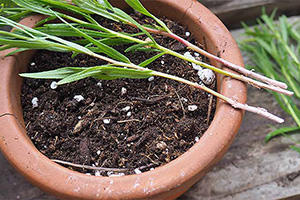 This healing herb can help treat stomach aches, toothaches, and insomnia. Tarragon could also help improve insulin sensitivity and help regulate blood sugar. It can also help normalize sleep patterns and reduce pain associated with Osteoarthritis, as well as sparking an increase in appetite.
This healing herb can help treat stomach aches, toothaches, and insomnia. Tarragon could also help improve insulin sensitivity and help regulate blood sugar. It can also help normalize sleep patterns and reduce pain associated with Osteoarthritis, as well as sparking an increase in appetite.
Tarragon Growing Tips
#1. Seeds should be sown about four to six to a medium container.
#2. Plant the seeds in lightweight and moist potting soil.
#3. Tarragon seeds should be covered lightly with a paper towel or cotton cloth to facilitate low light conditions until they have sprouted.
#4. Once the seeds have grown at least two inches tall, they can be thinned out and each transplanted to their pot.
Dwarf Moringa Tree
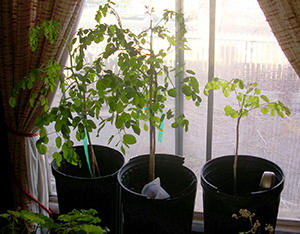 Not only can you eat nearly every part of the Moringa Tree, but is it also packed with so many healing properties that it has long been nicknamed, “The Tree of Life.” Moringa trees are also highly regarded for how rapidly they grow. Unfortunately for preppers who do not live in the southern regions of Florida, Texas, California, and Arizona, growing these trees has long been thought impossible.
Not only can you eat nearly every part of the Moringa Tree, but is it also packed with so many healing properties that it has long been nicknamed, “The Tree of Life.” Moringa trees are also highly regarded for how rapidly they grow. Unfortunately for preppers who do not live in the southern regions of Florida, Texas, California, and Arizona, growing these trees has long been thought impossible.
Growing dwarf moringa trees indoors is entirely feasible no matter what climate you happen to be located in. It cost me $3.50 to purchase a packet of 10 dwarf Moringa tree seeds – and they all sprouted within a single week.
- Moringa trees are rich in vitamins A, B, C, E, and K, protein, essential amino acids, beta-carotene, and manganese.
- Both the gum and the bark from the tree can be eaten to garner their medicinal properties and nutrients.
- The leaves from the tree can be eaten raw, dehydrated, or infused into the tea.
- The pods can be cracked out and the inside consumed or eaten much like okra.
- Flowers from the moringa tree can be eaten raw but are far tastier when fried or broiled.
- The seeds growing inside the drumstick portion of moringa trees contain ben oil. Not only is the oil a powerful component in natural remedies, but it can also be used as a mechanical and firearms lubricant. The oil can also be used to filter water to make it potable.
It will take two weeks for the moringa tree seeds you plant in a container that is 16 inches in diameter, to sprout. You can plant about eight seeds in a single container and then thin them out as needed. You can pinch off the leaves of the growing dwarf tree to use for medicinal purposes as it grows into its mature state.
Moringa trees do not grow well in soggy soil and will need to be placed in both soil and a container that facilitates quality drainage. If the leaves on the tree begin to turn yellow, add some magnesium to the dirt – egg shells, Epsom salts, or oyster shells are highly recommended.
Turmeric
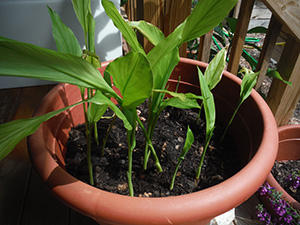 If you could only grow one medicinal plant indoors, it should be turmeric. This bright orange spice is the only source of the powerful antioxidant, curcumin. This turmeric component is garnered from the dried rhizome or root cuttings, of the turmeric plant.
If you could only grow one medicinal plant indoors, it should be turmeric. This bright orange spice is the only source of the powerful antioxidant, curcumin. This turmeric component is garnered from the dried rhizome or root cuttings, of the turmeric plant.
Curcumin has been used by herbalists for thousands of years and it has been found to reduce joint and muscle inflammation and arthritis stiffness. It may also be beneficial for enhancing brain health and function and in fighting certain cancers, depression, and Alzheimer’s.
A United States National Library of Medicine and National Institutes of Health study maintains curcumin might also improve endothelium (blood vessel lining) function – helping to prevent heart disease.
Turmeric Growing Tips
#1. Purchase root cuttings at a local supplier or online. One turmeric root should be enough to grow multiple new cuttings.
#2. Break up the rhizome into small portions. Each one of the pieces must have at least one bud on it for it to grow.
#3. In a large growing container (5-gallon bucket recommended) place one of the rhizome pieces. The larger the pot, the bigger and stronger the turmeric start will to grow. The growing container must have drainage holes drilled into the bottom to prevent the rootstock from becoming oversaturated. Plant the starts in potting soil that have been slightly moistened.
#4. The turmeric rhizomes should be planted two inches deep. The buds on the rootstock must be facing upward.
#5. Turmeric quickly thrives in full sun conditions, but will still flourish beneath grow lights. It is highly recommended to move the growing container outside during the late spring and summer months – but only after the threat of any lingering frost has passed.
#6. Turmeric should be watered approximately every two days to ensure it remains moist beneath the hot summer sun or artificial grow lights. Misting the turmeric lightly in between waterings may also be necessary to prevent the soil from drying out. Be mindful not to make the soil soggy or it will likely cause the turmeric to rot.
#7. It typically takes between eight to 10 months for the turmeric to mature. Harvest each root as one whole piece. Remember to save some pieces of the rhizome for starting more turmeric. Never replant in the same soil the turmeric was just harvested from, it will be too depleted of nutrients.
To process the harvested turmeric, boil the rhizomes for around 45 minutes. Place them on a drying rack in a spot that is no hotter than room temperature (cooler is better, but the spot cannot be damp) for seven days. Peel the dried rhizomes and powder the insides. Wear gloves, turmeric will stain anything it touches orange.
Related: How to Make All-Natural Homemade Turmeric Drops
Garlic
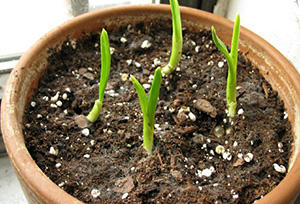 Garlic is a natural wonder “drug.” This hardy and easy yet time-consuming to grow medicinal plant is a base ingredient in 98 percent of the natural remedies I make.
Garlic is a natural wonder “drug.” This hardy and easy yet time-consuming to grow medicinal plant is a base ingredient in 98 percent of the natural remedies I make.
Garlic Top Medicinal Uses
- Draws toxins and impurities out of the body
- Treats and prevents gum disease
- Helps treat common cold and flu symptoms, especially a persistent cough
- Treats yeasts infections
- Garlic oil helps remove splinters
- Heals cold sore
- Soothes yeast infection discomfort and helps correct the problem
Garlic Growing Tips
#1. Cloves can be planted in the same container but must be spaced 1 to 2 inches apart.
#2. The root side of the clove – the narrow pointy part, must be placed up into the dirt first.
#3. Plant the cloves between four to six inches deep in compost-rich potting soil.
Related: How To Prepare Medicinal Pickled Garlic
Ginger
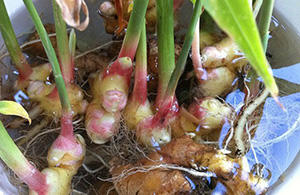 This medicinal root is highly regarded for its antioxidant, antibacterial, antiviral, and anti-nausea properties. Ginger’s anti-inflammatory properties make it a valuable natural remedy ingredient when combating headaches, migraines, joint pain, and menstrual problems.
This medicinal root is highly regarded for its antioxidant, antibacterial, antiviral, and anti-nausea properties. Ginger’s anti-inflammatory properties make it a valuable natural remedy ingredient when combating headaches, migraines, joint pain, and menstrual problems.
Ginger Growing Tips
#1. Purchase ginger root from a garden supply store or get a root cutting from a friend. The root should boast a firm skin, be plump, firm, and have multiple eyes on it – similar to the type of buds that grow on potatoes.
#2. Cut the ginger root into sections that each contain one bud.
#3. Soak the ginger root pieces in warm water for eight to 12 hours. Drain the water and shake the root sections to a semi-dry state before planting.
#4. The ginger root grows horizontally and will need a wide plant and well-draining compost-rich potting soil to thrive.
#5. Plant the root with the eye pointing toward the soil surface.
#6. Plant the root sections one to inches deep and immediately water lightly.
#7. Ginger should not get a lot of sunlight and the container needs to stay warm throughout the growing period.
#8. The soil needs to remain moist but fight the urge to overwater.
#9. Ginger sprouts should become visible in 14 to 21 days. It takes several months of growth before portions of the ginger root can be cut away and harvested.
Peppermint
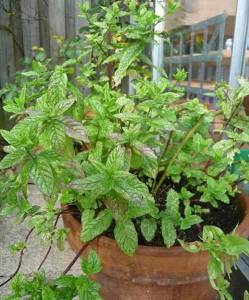 This sweet herb can be used as a base ingredient in common cold and flu remedies designed to treat coughs and respiratory problems. Peppermint can also be a vital ingredient in natural asthma, tuberculosis, allergy, and digestive issues home remedies.
This sweet herb can be used as a base ingredient in common cold and flu remedies designed to treat coughs and respiratory problems. Peppermint can also be a vital ingredient in natural asthma, tuberculosis, allergy, and digestive issues home remedies.
Peppermint Growing Tips
#1. Peppermint should be planted by a window that offers only light sun or partial shade.
#2. It grows best in lightweight and moist potting soil.
#3. Place Light Full sun to part shade.
#4. Space started plants approximately 18 to 24 inches apart.
#5. Mature peppermint plants typically grow to hit one foot to three feet tall.
Echinacea
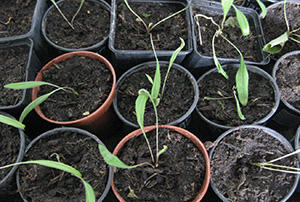 This beautiful plant can be brewed into tea to help prevent and fight the common cold, flu, and related respiratory conditions. Adults often consume the tea in a standard coffee cup, up to our times daily as soon as they begin to feel ill. It may take a week to 10 days of the echinacea tea treatment to defeat cold and cough symptoms.
This beautiful plant can be brewed into tea to help prevent and fight the common cold, flu, and related respiratory conditions. Adults often consume the tea in a standard coffee cup, up to our times daily as soon as they begin to feel ill. It may take a week to 10 days of the echinacea tea treatment to defeat cold and cough symptoms.
Echinacea has also been known to boost the immune system and help ward off infection, as well.
Echinacea Growing Tips
#1. These plants thrive on a small amount of water, yet the soil should not be allowed to dry out.
#2. Echinacea will grow best in nutrient-rich soil and full sun.
#3. This medicinal plant can survive a light frost if you ever need to move them outside.
#4. They take about 90 to 120 days to grow from seed to flower and can hit 48 inches tall.
Thyme
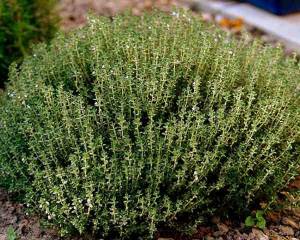 Thyme is one of the easiest to grow medicinal herbs and can be cultivated entirely indoors – even on a windowsill. This healing spice is believed to possess insecticidal, antiseptic, and antibacterial properties. Thyme was used to help protect people from the “Black Death” in Europe during the 1300s.
Thyme is one of the easiest to grow medicinal herbs and can be cultivated entirely indoors – even on a windowsill. This healing spice is believed to possess insecticidal, antiseptic, and antibacterial properties. Thyme was used to help protect people from the “Black Death” in Europe during the 1300s.
Brewed or steeped thyme may also help facilitate sleep and relieve stress. Drinking thyme tea can help curtail coughing fits and boost the immune system.
This medicinal herb is also comprised of thymol, a natural biocide compound. This compound can help destroy infectious bacteria and other types of destructive organisms. A 2010 study maintains thymol could reduce bacterial resistance to many types of commonly prescribed medications, including penicillin.
Thyme Growing Tips
#1. Grow in full sun.
#2. Provide a steady supply of water, but avoid watering too much,
#3. Use lightweight and well-drained potting soil.
#4. Thyme grows best in a pH balance of 6.5 to 7.0.
I grow 36 types of medicinal herbs, plants, and roots inside our home and in our greenhouse. But, if I had only the space, time, and money to grow eight medicinal plants to treat the most several and common health issues that could arise during an SHTF event, these would without a doubt be the ones I would recommend most.
I Used To Cut This Plant Until I Saw This!
Similar to Morphine: The Best Natural Painkiller that Grows in Your Backyard (Video)
Delicious Recipes Using Cattails: The Supermarket of the Swamp
How to Make Cabbage Bandages to Treat Inflammation and Joint Pain

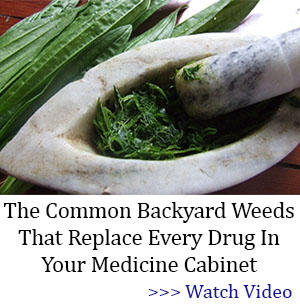
Garlic is planted with the pointy end facing UP, not down.
Hi Devon,
Thank you so much for bringing this to our attention. You are right. We have revised the article.
God bless!
The root side is not the pointy side. The pointy side is where the garlic shoot comes out. Most bulbs are this way, including onions.
This was very good and I am going to ad a few of these to my plants that we have.
I live in Idaho and growing some of these indoors will be great. I have your book and I am really enjoying it. Thank you.
Hi Jeff,
Thank you so much for your comment and for your kind words as well. We really appreciate it.
God bless!
Rookie question: are these plants for indoors safe for pets? Specifically cats.
Hi Jay,
Thank you so much for your comment. the only toxic plants for cats which can be found in the article are tarragon, peppermint and garlic. The rest of them are safe for cats.
God bless!
I really enjoyed the book, But the question I have is where would you get these items?
Hi Mickey,
Thank you so much for your kind words. We are really glad you liked the book. We would suggest you find a local botanist and purchase from them or you can find medicinal seeds on Amazon. Also there are a couple of specialized online medicinal seeds stores. It is best to use Google to find one that delivers to your area.
God bless!
Waiting for my book!!!!!!!! I I really love all of your information❤️
I live in the UK ENGLAND
Can I grow indoor plants you listed
How much thyme would you use for tea as a cough medicine?
What kind of lavendar seeds are in the seed kit? I understand it can be difficult to grow most lavendars in the south due to high humidity.
Good insight